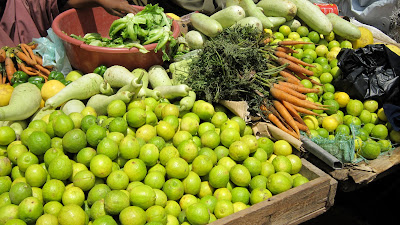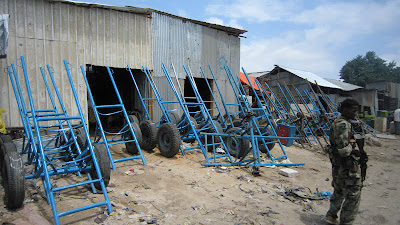Inside Bakara Market- Mary Harper
During a recent trip to Mogadishu, I was lucky enough to visit Bakara market, the main commercial area of the city. 'Market' is a misleading term for Bakara; it is more a 'commercial district' covering a large area, comprising many streets, alleys, open areas and buildings. It was until last year a stronghold of the Islamist group, Al Shabaab, and one of its main sources of revenue.
We started off at one of Bakara's most glamorous buildings, the headquarters of the Hormuud telecommunications giant. At this stage, I felt as if I was in any East/ Horn of African city such as Nairobi or Addis Ababa. People streamed in and out of the building, simply going about their business, as traffic jams built up outside.
 |
| Hormuud building |
 |
| Me outside Hormuud |
 |
We then went past African Express Airways, the airline I took to fly into Mogadishu (it is very difficult to get a seat because so many people are flooding back to the city, either on holiday or to stay permanently).
|
We set off on foot into the market. Trucks, buses, cars and donkeys loaded with goods and people streamed into Bakara.
 |
| Somali lorry drivers are famous all over Africa. They dominate transport networks in many parts of East Africa, the Horn of Africa and beyond. I have recently been told they are active in Africa's newest country, South Sudan, and in parts of the Democratic Republic of Congo. |
 |
| Unloading rice |
 |
I am not sure how the driver could see beyond all the rosettes on his front window
|
Although it is just a year since Al Shabaab left Bakara, there has been a lot of rebuilding and repainting. Pastel shades of blue, yellow and pink seemed to be the colours of choice.
We walked down Pharmacy Street, which seemed to go on forever. Shop after shop, kiosk after kiosk, stall after stall, offered an amazing array of medicines for sale.


 |
I think this is a sign for Viagra, the drug that enhances sexual performance in men
After our long walk down Pharmacy Street, we entered what I felt was the heart of the market, where the streets and open spaces were crammed with different items for sale. The market is informally divided up into specialist areas. We started off in what I called Suitcase Street.
We then moved on to 'Shoe Street':
Then 'Material Street'. I noticed a lot of the bright, patterned gauzy material used to make the traditional Somali women's dress which was forbidden by the Islamist militia Al Shabaab, which insisted on thick, dark cloth completely covering the head and body. Most women I saw in Mogadishu were wearing darker, duller colours, but many had their faces were exposed.
Next was the fruit and vegetable market. Most of it is grown locally, in the Afgoye area not far from Mogadishu. Trade here was brisk as people bought supplies for iftar, the evening meal eaten to break the Ramadan fast. I asked why I didn't see much of the narcotic leaf qat for sale (this was banned by Al Shabaab), and was told it would be back on the streets in greater supply after Ramadan.
We then reached the meat market where giant slabs of red meat swung in the sunlight. The second photo shows long strips of meat called oodkac or or kalaankal or muqmad. The meat is dried, then chopped into small pieces and fried in ghee. It is served on special occasions such as weddings. In the third photo, a man is sharpening his knives in preparation for slicing off a hunk of meat for a customer:
As we moved into a dusty, more open part of the market, we walked past a lorry piled high with jerry cans. I was told there are no petrol stations in Mogadishu, so people use these to fill their vehicles.
I fell in love with these tin money boxes painted with pictures of US dollars. Merchants store cash in them under their kiosks and in their shops. I wanted to buy one (I was told they cost $25) but it was too big to take home.
We moved on to the grain market. I noticed some of the bags said 'World Food Programme - Not For Sale'. The traders ignored this instruction:
One variety of grain attracted a lot of insects. I am not sure whether they were flies, bees, wasps or something else:
The next part of the market seemed very poor. Traders were selling old plastic bottles and tins.
The next part of the market sold charcoal. Al Shabaab makes a lot of money exporting charcoal from the southern port of Kismayo to the Gulf. The US president, Barack Obama, has recently banned the import to the US of Somali charcoal. The air in this part of the market was black with charcoal dust, so I emerged very sooty.
Here was the industrial part of Bakara. Blacksmiths made blue metal carts for donkeys to pull:
There was a bicycle repair area:
A place to make safes:
The ground in the area selling and fixing tyres was covered in pieces of old tyre that had somehow melted into the soil:
We left the dusty part of Bakara, emerging onto another busy street selling fresh bread and watermelons for the iftar feast:
The doors and shutters of all the restaurants were firmly closed as it was Ramadan.
Walking through this part of Bakara reminded me of trying to squeeze through the crowds of Oxford Street in London. It was packed with shoppers.
My last stop in Bakara was the police station based in a former headquarters for Al Shabaab. There was a lot of Arabic writing on the walls, which spelled out the full name of the movement, Harakat al-Shabaab al-Mujahideen.
I spoke to the man in charge of Bakara market, Commander Sokor. He told me that when he first entered Bakara last year, he found suicide vests, explosive devices and incriminating documents left behind by Al Shabaab. He said the most disturbing thing he saw was inside a school which had been used to store the remains of people executed by Al Shabaab. He said some of them had been beheaded. He told me that even when Al Shabaab buried people, they didn't do it properly, but threw them on the ground and sprinkled some sand over their bodies.
As we were speaking a ferocious gunfight started outside the window. He immediately got on the phone and bent down to grab a large gun that had been lying under his desk. I asked him what was going on. He said it was probably a robbery and that I shouldn't worry as it was small arms fire.
I was told that elements of Al Shabaab remain in Bakara. The atmosphere there is sometimes quite jittery, which is not surprising as there are frequent grenade and other attacks.
On the way to the police station, I saw the security forces harassing a boy with two large yellow plastic bags filled with something heavy. The boy was sobbing as he was being roughed about. I asked why he was being treated in this way, and was told the bags appeared to contain something suspicious.
|
http://samotalis.blogspot.com/

































































No comments:
Post a Comment